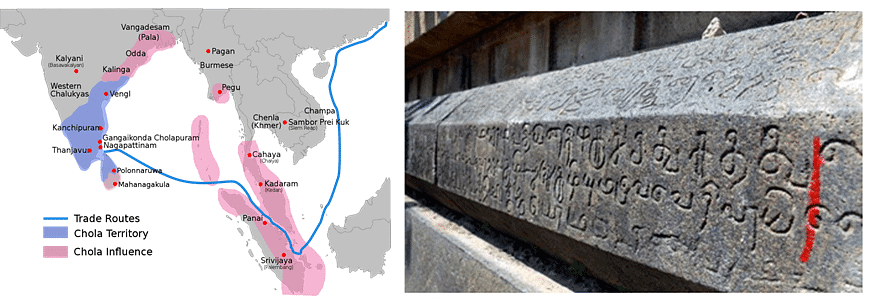Regional State during Gupta Empire- III - UPSC PDF Download
Chalukyas
Introduction
- The Chalukya dynasty refers to an Indian royal dynasty that ruled large parts of southern and central India between the sixth and twelfth centuries.
- During this period, they ruled as three closely related, but individual dynasties.
- The earliest dynasty, known as the Badami Chalukyas, ruled from their capital Badami from the middle of the sixth century.
- The Badami Chalukyas began to assert their independence at the decline of the Kadamba kingdom of Banavasi and rapidly rose to prominence during the reign of Pulakesi II.
- After the death of Pulakesi II, the Eastern Chalukyas became an independent kingdom in the eastern Deccan.
- They ruled from the capital Vengi until about the eleventh century.
- In the western Deccan, the rise of the Rashtrakutas in the middle of eighth century eclipsed the Chalukyas of Badami before being revived by their descendants, the Western Chalukyas in late tenth century.
- Those Western Chalukyas ruled from Basavakalyan till the end of the twelfth century.
Significance
- The rise of the Chalukyas marks an important milestone in the history of South India and a golden age in the history of Karnataka.
- The political atmosphere in South India shifted from smaller kingdoms to large empires with the rise of Badami Chalukyas.
- For the first time in history, a South Indian kingdom took control and consolidated the entire region between the Kaveri and the Narmada rivers.
- The rise of that empire also saw the birth of efficient administration, rise in overseas trade and commerce and the development of new style of architecture called Vesara.
- Around the ninth century, it also saw the growth of Kannada as a language of literature in the Jaina Puranas, Veerashaiva Vachanas and Brahmanical traditions.
- Further, the eleventh century saw the birth of Telugu literature under the patronage of the Eastern Chalukyas.
Sources of Chalukyan History
- Inscriptions constitute the main source of information about the Badami Chalukya history. Important among them are:
- the Badami cave inscriptions (578) of Mangalesa
- Kappe Arabhatta record of 700
- Peddavaduguru inscription of Pulakesi II
- the Kanchi Kailasanatha inscription and
- Pattadakal Virupaksha Temple inscriptions of Vikramaditya II
- Hiuen-Tsiang, a Chinese traveller visited the court of Pulakesi II
- At the time of that visit, as mentioned in the Aihole record, Pulakesi II had divided his empire into three Maharashtrakas or great provinces comprising of 99,000 villages each.
- That empire possibly covered present day Karnataka, Maharashtra and coastal Konkan
- Vidyapati Bilhana, the famous poet in the court of Vikramaditya VI of the Western Chalukya dynasty of Kalyana, mentions a legend in his work, Vikramankadeva Charita, which has been used to reconstruct History as well.
History of the Chalukyas
Chalukyas of Badami
- In the sixth century, with the decline of the Gupta dynasty and their immediate successors in northern India, major changes began to happen in the area south of the Vindyas— the Deccan and Tamilaham
- Pulakesi I established the Chalukya dynasty in 550.
- He took Vatapi (Badami in Bagalkot district, Karnataka) under his control and made it his capital.
- They ruled over an empire that comprised the entire state of Karnataka and most of Andhra Pradesh in the Deccan.
- Further, Pulakesi II had been perhaps the greatest emperor of the Badami Chalukyas.
- Pulakesi II extended the Chalukya Empire up to the northern extents of the Pallava kingdom and halted the southward march of Harsha by defeating him on the banks of the river Narmada.
- Later, the Badami Chalukya dynasty went into a brief decline following the death of Pulakesi II due to internal feuds.
- It recovered during the reign of Vikramaditya I, who succeeded in pushing the Pallavas out of Badami and restoring order to the empire.
- The empire reached a peak during the rule of the illustrious Vikramaditya II
- Eventually, the Rashtrakuta Dantidurga overthrew the last Badami Chalukya king Kirtivarman I in 753.
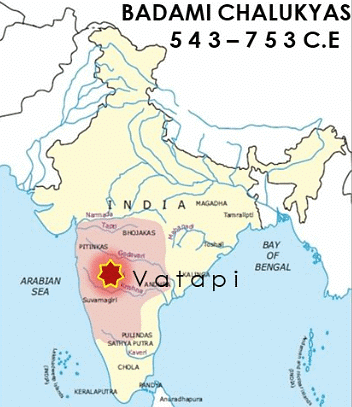
Chalukyas of Kalyani
- The Chalukyas revived their fortunes in 973 C.E., after over 200 years of dormancy when the Rashtrakutas dominated much of the Deccan.
- The reign of the Kalyani Chalukyas had been a golden age in Kannada literature.
- Tailapa II, a Rashtrakuta feudatory ruling from Tardavadi-1000 (Bijapur district) overthrew Karka II and re-established the Chalukyan kingdom and recovered most of the Chalukya empire.
- This dynasty came to be known as the Western Chalukya dynasty or Later Chalukya dynasty.
- Scholars widely considered Vikramaditya VI the greatest ruler of the dynasty; his 50 year reign called Chalukya Vikrama Era.
- Later, the Western Chalukyas went into their final dissolution 1180 with the rise of the Hoysalas, Kakatiya and Seuna.
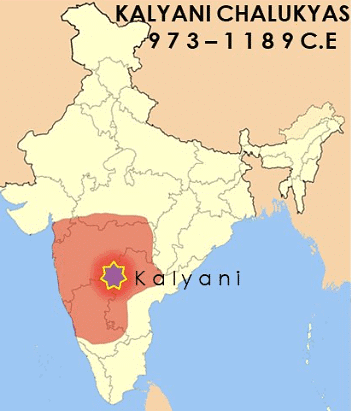
Eastern Chalukyas
- Pulakeshin II conquered the eastern Deccan, corresponding to the coastal districts of modern Andhra Pradesh in 616, defeating the remnants of the Vishnukundina kingdom.
- After the death of Pulakeshin II, the Vengi Viceroyalty developed into an independent kingdom and included the region between Nellore and Visakhapatnam.
- After the decline of the Badami Chalukya empire in the mid-8th century, territorial disputes flared up between the Rashtrakutas, the new rulers of the western deccan, and the Eastern Chalukyas.
- Later, the fortunes of the Eastern Chalukyas took a turn around 1000 C.E.
- Initially, the Eastern Chalukyas had encouraged Kannada language and literature, though, after a period of time, local factors took over and they gave importance to Telugu language.
Art and Architecture
- The period of Badami Chalukya dynasty saw art flourish in South India.
- It brought about some important developments in the realm of culture, particularly in the evolution and proliferation of a new style of architecture known as Vesara, a combination of the South Indian and the North Indian building styles.
- One of the richest traditions in Indian architecture took shape in the Deccan during that time, called Karnataka Dravida style as opposed to traditional Dravida style.
- The Kalyani Chalukyas further refined the Vesara style with an inclination towards Dravidian concepts, especially in the sculptures. They built fine monuments in the Tungabhadra – Krishna river doab in present day Karnataka.
- Badami Chalukyas
- More than 150 monuments attributed to the Badami Chalukya, and built between 450 and 700, remain in the Malaprabha basin in Karnataka.
- The rock-cut temples of Pattadakal, a UNESCO World Heritage Site, Badami and Aihole constitute their most celebrated monuments. This marks the beginning of Chalukya style of architecture and a consolidation of South Indian style.
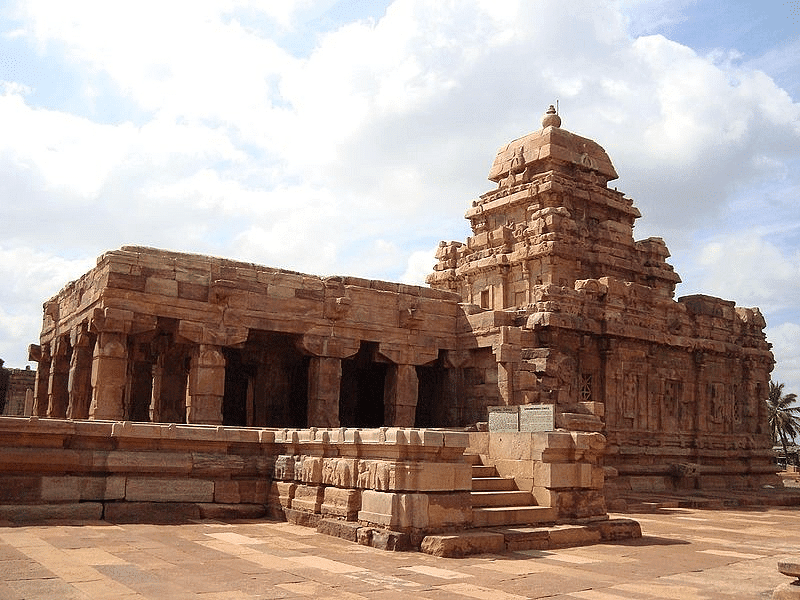 Pattadkal Temple Architecture
Pattadkal Temple Architecture
- In Aihole, the Durga temple (sixth century), Ladh Khan temple (450), Meguti temple (634), Hucchimalli and Huccappayya temples (fifth century), Badami Cave Temples (600) provide examples of early Chalukyan art.
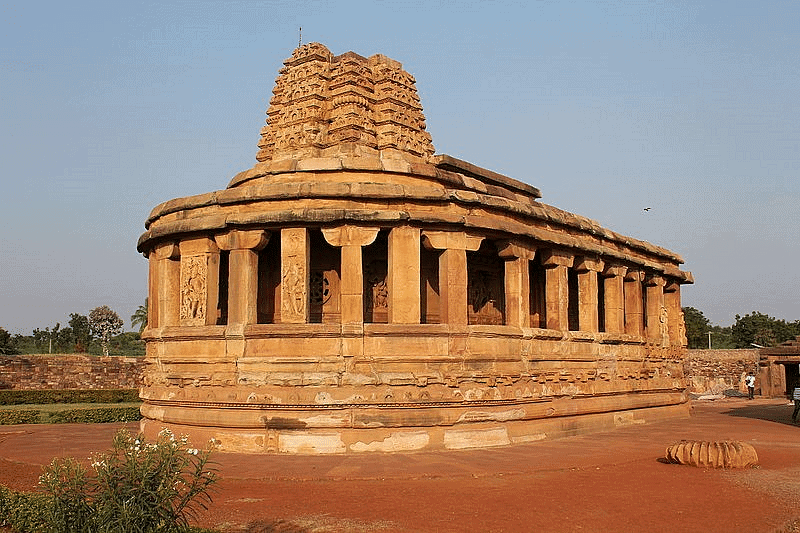 Aihole Temple Architecture
Aihole Temple Architecture
Literature
- The rule of the Chalukyas embodies a major event in the history of Kannada and Telugu languages.
- During the ninth – tenth century, Kannada language had already seen some of its greatest writers. The three gems of Kannada literature, Adikavi Pampa, Sri Ponna and Ranna belonged to that period
- In the eleventh century, the patronage of the Eastern Chalukyas, with Nannaya Bhatta as its first writer gave birth to Telugu literature.
- Famous writers in Sanskrit from that period include Vijnaneshwara who achieved fame by writing Mitakshara a book on Hindu law.
- Somesvara III became a great scholar and king, compiling an encyclopedia of all arts and sciences called
- From the period of the Badami Chalukya no major Kannada literary work has been recovered, though many works have been referenced in later centuries.
- The extant Kappe Arabhatta record of 700 in tripadi (three line) metre represents the earliest work in Kannada poetics.
- The literary work Karnateshwara Katha, quoted later by Jayakirti, belonged to the period of Pulakesi II with the great king himself as the hero.
- Other Kannada writers of that time included Syamakundacharya of 650 who wrote Prabhrita, the celebrated Srivaradhadeva also called Tumubuluracharya of 650 (who wrote Chudamani, a commentary on Tattvartha-mahashastra in 96,000 verses)
Badami Chalukya Government
- Army
- The army consisted of infantry, cavalry, elephant corps and a powerful navy.
- Rashtrakuta inscriptions use the term Karnatabala referring to their powerful armies.
- The government levied taxes called Herjunka, Kirukula, Bilkode, and Pannaya.
- Land governance
- The empire was divided into Maharashtrakas (provinces), then into smaller Rashtrakas (Mandala), Vishaya (district), Bhoga (group of ten villages).
- Later, many autonomous regions existed ruled by feudatories like Alupas, Gangas, Banas, and Sendrakas. Local assemblies looked after local issues.
- Groups of mahajanas (learned brahmins), looked after agraharas (like Ghatika or place of higher learning) like the ones at Badami (2000 mahajans) and Aihole (500 mahajanas).
- Coinage
- The Badami Chalukyas minted coins of a different standard compared to the northern kingdoms.
- The coins had Nagari and Kannada
- They minted coins with symbols of temples, lion or boar facing right, and the lotus. The coins weighed four grams, called honnu in old Kannada and had fractions such as fana and the quarter fana, whose modern day equivalent being hana (literally means, money)
- Religion
- The rule of the Badami Chalukya proved a period of religious harmony.
- They initially followed Vedic Hinduism, as seen in the various temples dedicated to many popular Hindu deities with Aihole
- Later, from the time of Vikramaditya I, the people took an inclination towards Shaivism and sects like Pashupata, Kapalikas and Kalamukhas existed.
- They actively encouraged Jainism, attested to by one of the Badami cave temples and other Jain temples in the Aihole complex.
- Society
- The Hindu caste system appeared .
- Sati may have been absent as widows like Vinayavathi and Vijayanka are mentioned in records.
- Devadasis’ appeared in temples.
- Sage Bharata’s Natyashastra the precursor to Bharatanatyam, the dance of South India had been popular as seen in many sculptures and mentioned in inscriptions.V
- Women enjoyed political power in administration.
Conclusion
Thus, the Chalukya era may be seen as the beginning in the fusion of cultures of northern and southern India making way for the transmission of ideas between the two regions.
This becomes clear from an architectural point of view as the Chalukyas spawned the Vesara style of architecture including elements of the northern nagara and southern dravida styles.
The expanding Sanskritic culture mingled in a region where local Dravidian vernaculars had already become popular.
During the Chalukya rule, the Bhakti movement gained momentum in south India in the form of Ramanujacharya and Basavanna later spreading to north India.
Chola Empire
Sources:
- More than 10,000 inscriptions engraved on copper and stone form the primary sources for the study of Chola history.
- The inscriptions mainly record the endowments and donations to temples made by rulers and other individuals. Land transactions and taxes (both collections and exemptions) form an important part of their content
- Besides stone inscriptions, copper plates contain the royal orders. They also contain details of genealogy, wars, conquests, administrative divisions, local governance, land rights and various taxes levied.
- Literary sources, as tamil literature flourished during this period. Rise in bhakti saints and compilation of hyms reflect sociocultural features of that period Muvarula, and Kamba Ramayanam, the great epic, belong to this period
- Uttarameruru Inscription issued by Pranthaka Chola gives details of election to local self governance bodies.
Political history:
- Records available to us after the Sangam Age show that the Cholas remained as subordinates to the Pallavas in the Kaveri region. The re-emergence of Cholas began with Vijayalaya (850–871 CE) conquering the Kaveri delta from Muttaraiyar. He built the city of Thanjavur and established the Chola kingdom in 850.
- V ijayalaya’s illustrious successors starting from Parantaka I (907–955) to Kulothunga III (1163–1216) brought glory and fame to the Cholas. Parantaka Chola set the tone for expansion of the territory and broadened the base of its governance .
- Parantaka Chola suffered a defeat at the hands of the Rashtrakutas in the famous battle of Takkolam .
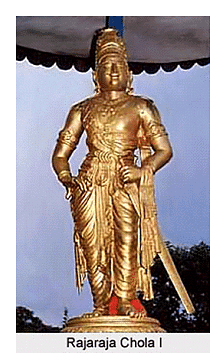
Rajaraja I (985 – 1014 A.D.)
- Rajaraja I is the most celebrated of the Chola kings. He engaged in naval expeditions and emerged victorious in the West Coast, Sri Lanka and conquered the Maldives in the Indian Ocean.
- The military victory of Raja Raja I over Sri Lanka led to its northern and eastern portions coming under the direct control of the Chola authority. He named noethern part of Sri lanka as mummidigonda cholamandalam.
- He defeated Cheras in the battle of Kandanur salai.
- He was also successful in expedition of western and Eastern chalukyas. He installed Shaktiverma on Vengi Throne.
- He constructed dam across kaveri river.
- He was a devout follower of Saivism. He completed the construction of the famous Rajarajeswara temple or Brihadeeswara temple at Tanjore in 1010 A.D.
- His titles: Mummidi Chola, Jayankonda and Sivapadasekara.
- He abdicted his throne for his son Rajendra chola 1.
Rajendra I (1012-1044 A.D.)
- Rajendra I conducted the most striking military exploit afer his accession in 1023 by his expedition to northern India.
- He defeated Mahipala 1 of Bengal.
- To commemorate this successful north-Indian campaign Rajendra founded the city of Gangaikondacholapuram and constructed the famous Rajesvaram temple in that city.
- Another famous venture of Rajendra was his naval expedition to Kadaram or Sri Vijaya(Indonesia).He got the title Kadaramgonda. He called Bay of Bengal as Cholamandalam.
- He annexed total Cylon(Sri lanka).
- He established many educational institutes in his empire, for this he got the title Pandita chola.
- After the death of Rajendra 1 , his three successors were also killed in short time.
Kulathunga Chola 1, grandson of Rajendra chola preserved the legacy of Imperial Cholas.
- He aboilished many taxes and got the title sungam tavirtta.
- He sent trade embassys to China
- He united the Vengi kingdom with the Chola Empire.
- He was contemporary to Ramanujacharya.
Rajendra III was the last Chola king who was defeated by Jatavarman Sundarapandya II
- On the ruins of Chola empire Pandya and Hoysala kingdom came into existence.
Administration:
- King: The emperor or king was at the top of the administration. All authority rested in his hands. He often went on tours in order to keep better touch with the administration .
- Chola rulers appointed Brahmins as spiritual preceptors or rajagurus (the kingdom’s guide). Rajaraja I and Rajendra I mention the names of rajagurus and Sarva-sivas in their inscriptions.
- Chola kings granted huge estates of land to Brahmins as brahmadeyams and caturvedimangalams.
- Provinces: The Chola Empire was divided into mandalams and each mandalam into valanadus and nadus.
- In each nadu there were a number of autonomous villages.
- The royal princes or officers were in charge of mandalam.
- The valanadu was under periyanattar and nadu under nattar. The town was known as nagaram and it was under the administration of a council called nagarattar
- Military administration: The Cholas maintained a large army consisting of infantry, cavalry and elephants which were called the three limbs of the army. The venetian traveler Marco Polo says that all the bodyguards of the king burnt themselves in the funeral pyre of the dead king.
- Revenue administration: For the purposes of assessing tax, the Cholas undertook extensive land surveys and revenue settlements. Rajaraja I (1001), Kulotunga I (1086) and Kulotunga III (1226) appointed people for land survey so that the land could be
- classified and assessed for the purposes of taxation.
- department of land revenue is known as puravuvari-tinaikkalam.
- Various units of the land measurement are kuli,ma, veli, patti, padagam, etc.
- The tax rates were fixed depending on the fertility of the soil and the status of the
- Besides land revenue, there were tolls and customs on goods taken from one place to another, various kinds of professional taxes, dues levied on ceremonial occasions like marriages and judicial fine
- Local Administration:There were two types of villages at the local in the Chola empire. One type of village consisted of people from different caste and the assembly which ran this type of village was called ‘ur’. The second type of village was ‘agrahara’ types of village which were settled by Brahmins in which most of the land was rent-free.
- The assembly of this agrahara type of village was a gathering of the adult men in brahmana villages called ‘Sabha’ or ‘mahasabha’. These villages enjoyed a large measure of autonomy.The affairs of the village were managed by an executive committees to which
- educated person owning property were elected by drawing lots or by rotation.
- Uttarameruru inscription issued by Prantaka Chola gives details of election to these committees.
Religion:
- Chola rulers were ardenSaiviteste. Shiva was the preeminent god for the Cholas and he was represented in two forms. The iconic form of Siva was Lingodhbhava, and the Nataraja idol was the human form.
- A highly evolved philosophical system called Saiva Siddhanta was founded during this period.
- Kulathunga Chola was ardent shaivite. He persecuted vaishnavites. Bhakti saint Ramnujacharya left Srirangam and settled in Melkote,Karntaka.
Society:
- Aryanisation was consolidated.
- Sanskritisation process was started from Chola times( Imitation of upper class tradition by lower class is called sanskritisation).
- Caste system was widely prevalent during the Chola period.
- Chola society witnessed a division of caste into “Idangai” and “Vadangai”.
- Serious clashes were started between shaivites and vaishnavites.
- Practice of sati became sacred
- A new social evil Devadasi system came into practice.
Literature:
- Tamil and Sanskrit language flourished during Chola period. Tamil literatue witnessed golden age.
- Few Tamil literary works are:
- Kamban Ramayan by Kamban (Tamil Ramayan)
- Periyapuranam or Tiruttondarpuranam by Sekkilar
- Kalladam by Kalladanar
- Nalavenba was written by Pugalendi etc.
- Kesava swami composed Sanskrit work nannaranava samkshevam.
Architecture:
- Chola art saw culmination of dravida temple art resulting in most sophisticated buildings
- Cholas followed the architectural style of the Pallavas deducting essential features of Pallavas such as lion motifs, for tigers, adding greater refinement etc. and were mostly involved in the construction of temples (Dravidian Style)
- They used material of stone instead of bricks due to its greater durability. Neatly detailed frescos including birds, dancing figurines and other pictorial stories from Puranas. Some temples have potraits of the Kings and queens themselves.
- The temples had a Garbhaghriha(Deity room); Vimana(Brihadeshwara Temple); Shikhara(Stone weighing 90 tonne); Mandap. Metal Art(Nataraja at Chidamabaram Temple) Lofty Gates
- Dvarpalas at the entrance of the mandap became a unique feature
- Temples were covered with exquisite well composed sculptures and frescoes
- Ganas are the most memorable figures were built during the chola period
- Yazhi a recurring pattern of the sclupted mythical animals were also a unique features
- Examples include Brihadeswara , Vijayalaya temples
- Presence of water tank is the unique feature of chola architecture.
Brihadeswara temple:
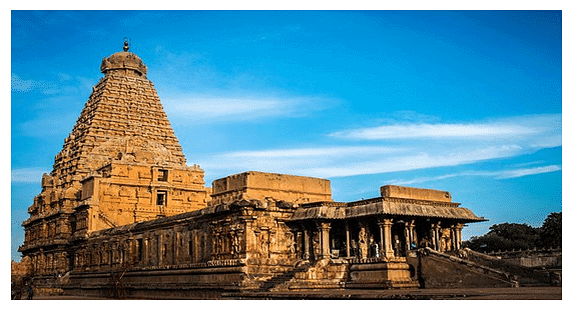
- The Grand Temple of Tanjavur, known as Rajarajisvaram and Brihadishvarar Temple, stands as an outstanding example of Chola architecture, painting, sculpture and iconography.
- Built by RajaRaja Chola
- It has shadowless vimana
- The sanctum with a vimana of 190 feet is capped with a stone weighing 80 tons
- The fIgures of Lakshmi, Vishnu, Ardhanarisvara and Bikshadana, a mendicant form of Siva, on the outer walls of the sanctum are some unique features.
- The fresco paintings and the miniature sculptures of the scenes from puranas and epics in the temple walls reveal the religious ideology of the Chola rulers.
- Gangaikonda Cholapuram: In commemoration of his victory in North India, Rajendra I built GangaikondChozhapuram on the model of Brihadisvarar temple
- Darasuram Temple : Darasuram Temple,built by Rajaraja II(1146–1172), is another testimony of Chola architecture.
Chola bronze sculptures:
- The cire-perdu or ‘lost-wax’ process for casting was learnt as long ago as the Indus Valley Culture.
- Along with it was discovered the process of making alloy of metals by mixing copper, zinc and tin which is called bronze.
- The bronze casting technique and making of bronze images of traditional icons reached a high stage of development in South India during the medieval period.
- Chola bronzes are the most sought-after collectors’ items by art lovers all over the world.
- The well-known dancing figure of Shiva as Nataraja was evolved and fully developed during the Chola Period and since then many variations of this complex bronze image have been modelled.
- A wide range of Shiva iconography was evolved in the Thanjavur (Tanjore) region of Tamil Nadu. The ninth century kalyanasundara murti is highly remarkable for the manner in which Panigrahana (ceremony of marriage) is represented by two separate statuettes.
- Shiva with his extended right hand accepts Parvati’s (the bride’s) right hand, who is depicted with a bashful expression and taking a step forward.
- The union of Shiva and Parvati is very ingeniously represented in the Ardhanarisvara Murti (in fig) in a single image.
- Beautiful independent figurines of Parvati have also been modelled, standing in graceful tribhanga posture.

